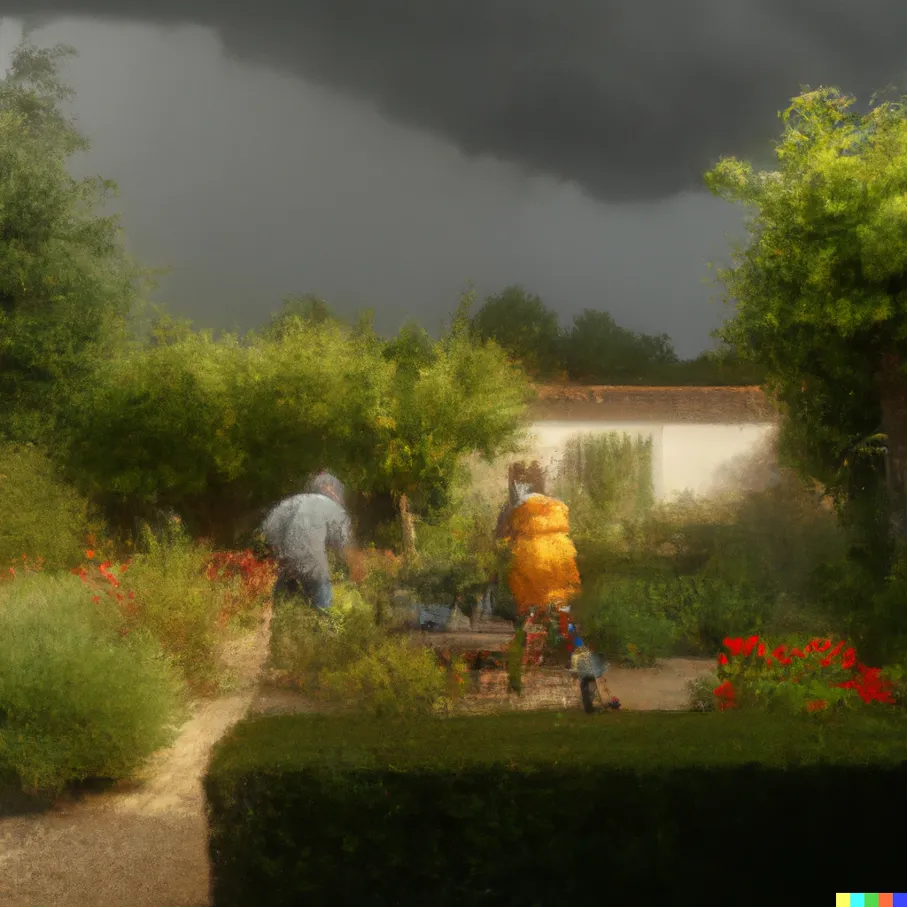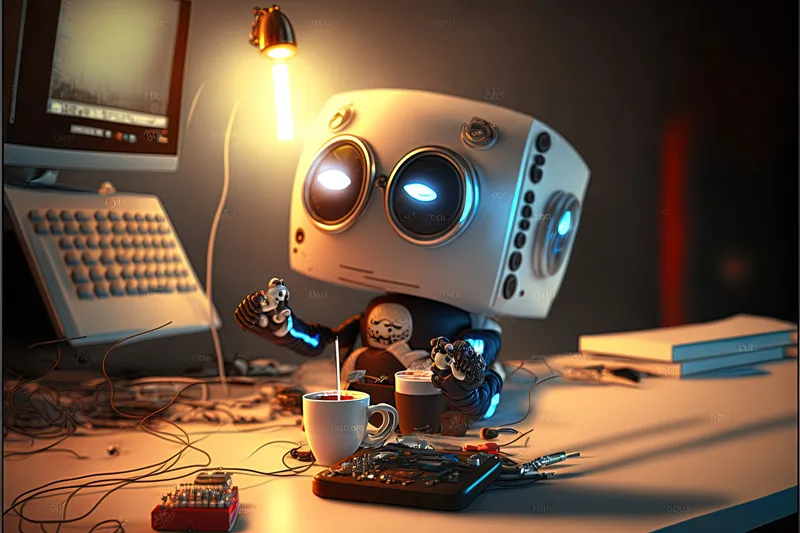You have probably heard of the OpenAI company, or at least of one of its products, DALL-E which generates drawings, and ChatGPT for its ” chats ” and which made the headlines these last weeks.
Here is a quick overview of these two applications, some information about OpenAI, the editor, and an example of dialogue.
About the images: DALL-E
DALL-E is an AI that can create realistic and artistic images from a natural language description. Ask for “a couple gardening, in the same way as a painting by Turner”, and here is the result in a few seconds:

No need to be surprised, these images are original: they have been built pixel by pixel at an astonishing speed by the AI. They are not extracted from an existing catalog. If we specify “under a storm”, here is an extract of the result:

DALL-E can create an endless number of combinations of this image. Here are some examples of scenes for “a couple gardening in the same way as a painting by Turner, under a storm”:

You can change the style, asking for example “Dali style”, or any other known painter or artist, or even according to your specifications, such as “using a pencil”:

DALL-E is a tool that can understand the description of natural language (in several languages), based on its own knowledge (gained through a long learning process). DALL-E makes statements based on this description. In our examples, we had to understand “storm” and “gardening” and know how to place these notions in the created image.
The use of DALL-E is free of charge up to a certain point, after which credits must be purchased.
Chat and knowledge: ChatGPT
ChatGPT is also an AI that understands natural language in 18 languages and relies on a very extensive (let’s say, encyclopedic) knowledge base acquired by 2021. In addition, this AI has the ability to understand a “conversation” by following the “thread” of the exchanges, in order to deduce on the basis of its knowledge and therefore answer the questions asked.
ChatGPT is pretty amazing! As soon as you don’t ask about current events (no need to ask about tomorrow’s weather), ChatGPT doesn’t just answer questions, but ” deduces “, i.e. produces a constructed answer, up to the point of producing contextual examples (= which take into account the thread of the discussion). ChatGPT can only produce text (no images or drawings), but this opens an incredible field.
Need for a computer algorithm: formulate a precise question to obtain a first example, then specify a language, and adapt with some complements. Need to solve an equation: describing it is enough. Find an equation from points: describe the sequence of points, for example in the form (x0,y0) … (xn,yn). In the appendix, I have copied a real dialogue on an unusual subject: the nature of kinetic energy.
Of course, ChatGPT’s answers will match the precision of the questions, and if you ask it to architect a software application or a building, it will explain in a relevant way why this cannot be a conversation.
ChatGPT is the result of twofold training: the knowledge acquisition on the one hand, and then the conversational aspect in which human AI trainers provided conversations in which they played both roles – the user and an AI assistant. These learning phases, as well as the operational phases, require very large computing power, in this case, provided by Microsoft’s Azure cloud.
But beware, ChatGPT is not perfect.
It relies on a body of knowledge established from media that OpenAI claims to be “of high quality”: books, scientific papers, computer code (including GitHub , which fuels controversy on the part of the programmers whose codes have been used), etc.
But even if it is considered qualitative, it has some imperfections, and ChatGPT may not always get the best of it. Here is for example what an article by France-Info describes its knowledge about Overseas: “It is often relevant but also makes big mistakes”. Please read the article to understand these mistakes.
We can therefore see ChatGPT as an assistant who has encyclopedic knowledge and on which we must always keep a critical distance.
About OpenAI
OpenAI is a San Francisco-based AI research and deployment company founded in 2015 that defines its mission as “making general artificial intelligence benefit all of humanity.” Companies such as Microsoft are involved in its funding.
OpenAI is working on DALL-E and ChatGPT, but also other research projects that have the common denominator of relying on AI and the exploration of languages ( script, images, audio) as well as the knowledge they allow to be inferred (the corpus of knowledge), e.g.: Connections between text and images (CLIP), Relationships between images (ImageGPT), Music Generator (JukeBox).
Companies like Google have similar programs, OpenAI is not alone in working in these areas, and a few web searches will quickly lead you to many similar projects.
The future?
The neural networks on which AI is built and trained are changing our daily lives. Beyond our daily lives, AI is producing results that advance science in general, including computer science itself.
For now, it seems to me that ChatGPT can be defined as a “super assistant” able to share and describe a really large amount of knowledge in a convenient and accessible way in 18 languages. That’s already a lot! Microsoft has just integrated ChatGPT in its office suite and should integrate it into its search engine Bing .
Since its exposure to the public (millions of users), and if I understood correctly, ChatGPT does not evolve on its knowledge, but evolves on its ability to lead a discussion.
At J2S, we are constantly evaluating these technologies, and several members of the team are AI specialists (by training and by having conducted research).
The goal is to make automation both simpler and more automatic, to make layout suggestions, to detect inconsistencies in the data, etc.
Interested in learning more about J2S?
Please feel free to
contact us.
D. Lantier
Business Developer











